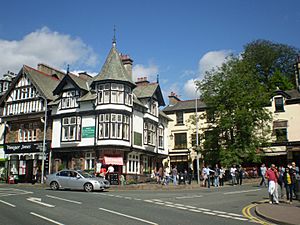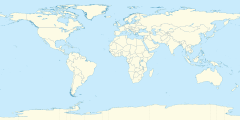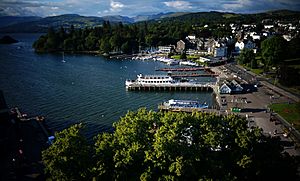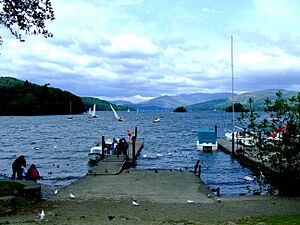Bowness-on-Windermere facts for kids
Quick facts for kids Bowness-on-Windermere |
|
|---|---|
| Town | |
 Bowness-on-Windermere town centre |
|
| Population | 3,814 |
| OS grid reference | SD403969 |
| Civil parish |
|
| Unitary authority |
|
| Ceremonial county |
|
| Region | |
| Country | England |
| Sovereign state | United Kingdom |
| Post town | WINDERMERE |
| Postcode district | LA23 |
| Dialling code | 015394 |
| Ambulance | North West |
| EU Parliament | North West England |
| UK Parliament |
|
Bowness-on-Windermere is a lovely town in Cumbria, England. It sits right next to the famous Lake Windermere and is very close to the town of Windermere. This area is part of the beautiful Lake District National Park.
Bowness-on-Windermere was once part of the historic county of Westmorland. Today, it forms a connected area with Windermere. In 2011, about 3,814 people lived here.
Contents
What's in a Name?
The name 'Bowness' comes from old English words. It means "the headland where the bull grazes." This might refer to a place where a special bull for the local area was kept. The "on-Windermere" part was added later, around 1899, to show its location by the lake.
A Glimpse into History
Bowness-on-Windermere has a long history. The old parish church of St Martin was built in 1483. However, there was likely an even older church building before that.
Around 1600, a grammar school was started in the town. A new school building opened in 1836. A local landowner named John Bolton helped pay for it. The famous poet William Wordsworth even helped lay the first stone for the new school.
During the 1800s, Bowness changed a lot. It grew from a small village where people mostly fished into a busy town. Most people started to work in tourism or with holiday homes. The town became a hub for building boats, like sailing yachts and steam launches, for use on the lake. Many hotels and guesthouses opened, giving jobs to local people.
Even royalty visited! Queen Adelaide stayed at the Royal Hotel in 1840. The arrival of the railway in 1847 in nearby Windermere helped the town grow even more.
Getting Around
Getting to and from Bowness-on-Windermere is easy.
- Trains and Buses: Windermere railway station is about 1.5 miles (2.4 km) from the lake. You can catch trains and buses there to nearby areas. You can also travel to bigger cities like Manchester and Manchester Airport.
- Local Buses: Both Stagecoach and the local council run frequent buses from Bowness Pier. Stagecoach has fun open-top double-decker buses that go through the town. They continue to Ambleside and Grasmere. The council's smaller buses are wheelchair-friendly and run around the town's edge.
- Lake Ferry: The Windermere Ferry is a special boat that carries cars. It connects Bowness on the east side of the lake to Far Sawrey on the west side. The trip takes about 10 minutes.
- Lake Cruises: For a relaxing trip, Windermere Lake Cruises offer regular boat trips. You can travel from Bowness Bay to the north end of the lake at Ambleside or the south end at Fell Foot.
Local Media and Fun Facts
Bowness-on-Windermere has its own local news and entertainment.
- TV and Radio: You can watch local TV news from BBC North West and ITV Border. Local radio stations include BBC Radio Cumbria and Heart North West.
- Newspapers: The town's local newspapers are The Westmorland Gazette and The Mail.
If you've read Arthur Ransome's Swallows and Amazons series of books, you might recognize Bowness. It's the lakeside town called 'Rio' in the stories. The Windermere Steamboat Museum has a real steamboat, TSSY Esperance, from 1869. This boat was one of the inspirations for Captain Flint's houseboat in the books!
Bowness-on-Windermere is also home to The World of Beatrix Potter attraction. It opened in July 1991 and was opened by the famous comedian Victoria Wood. It's a great place to explore the world of Peter Rabbit and his friends.
Images for kids
See also
 In Spanish: Bowness-on-Windermere para niños
In Spanish: Bowness-on-Windermere para niños





